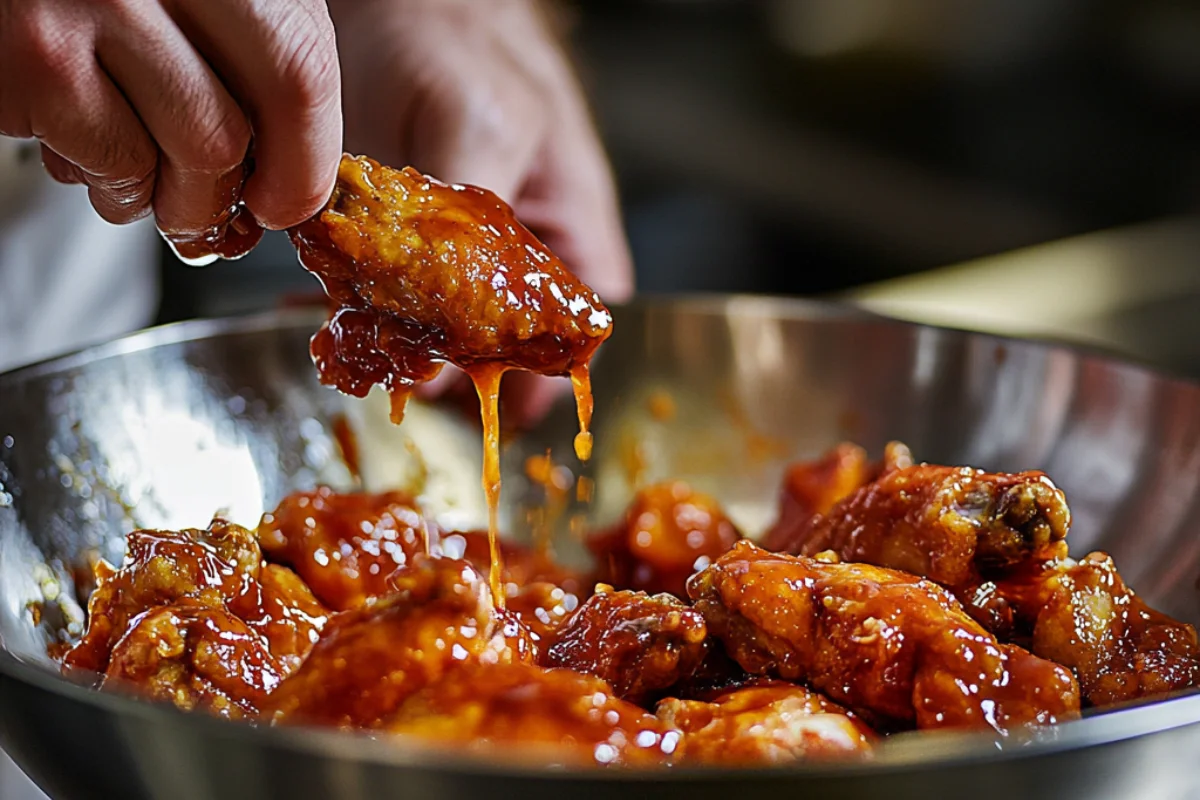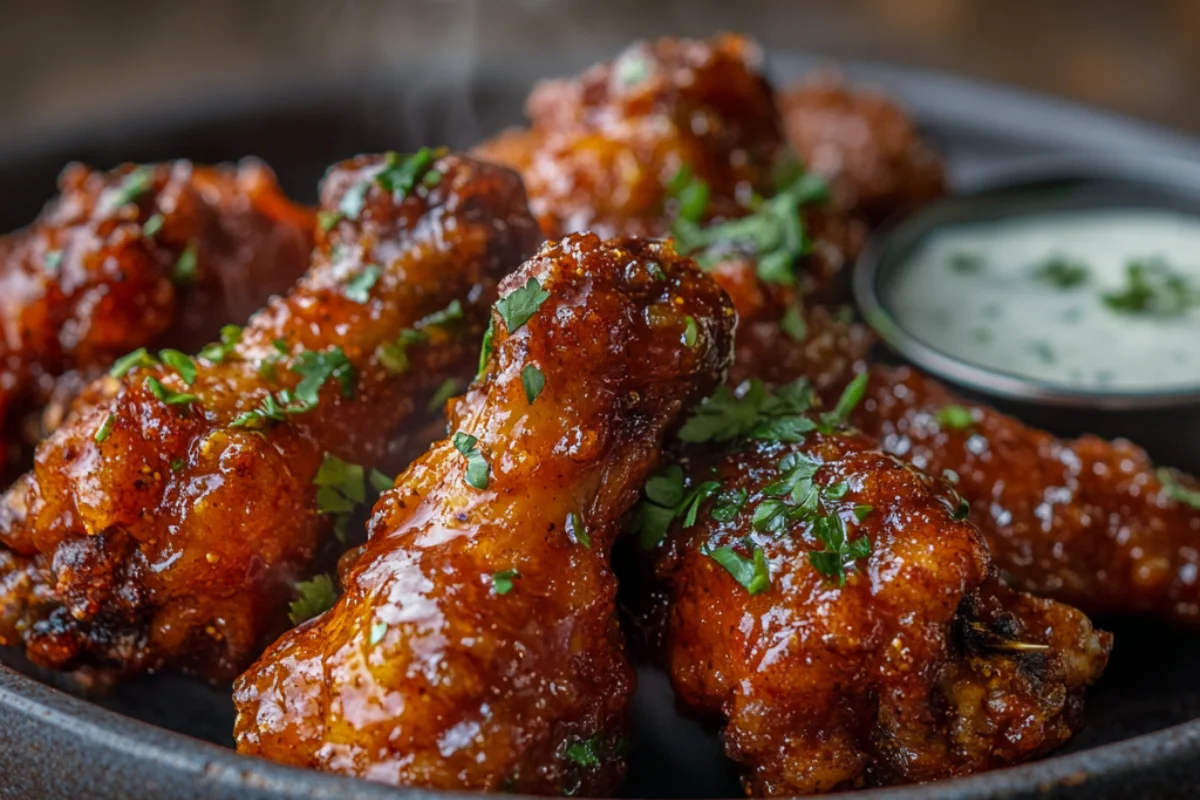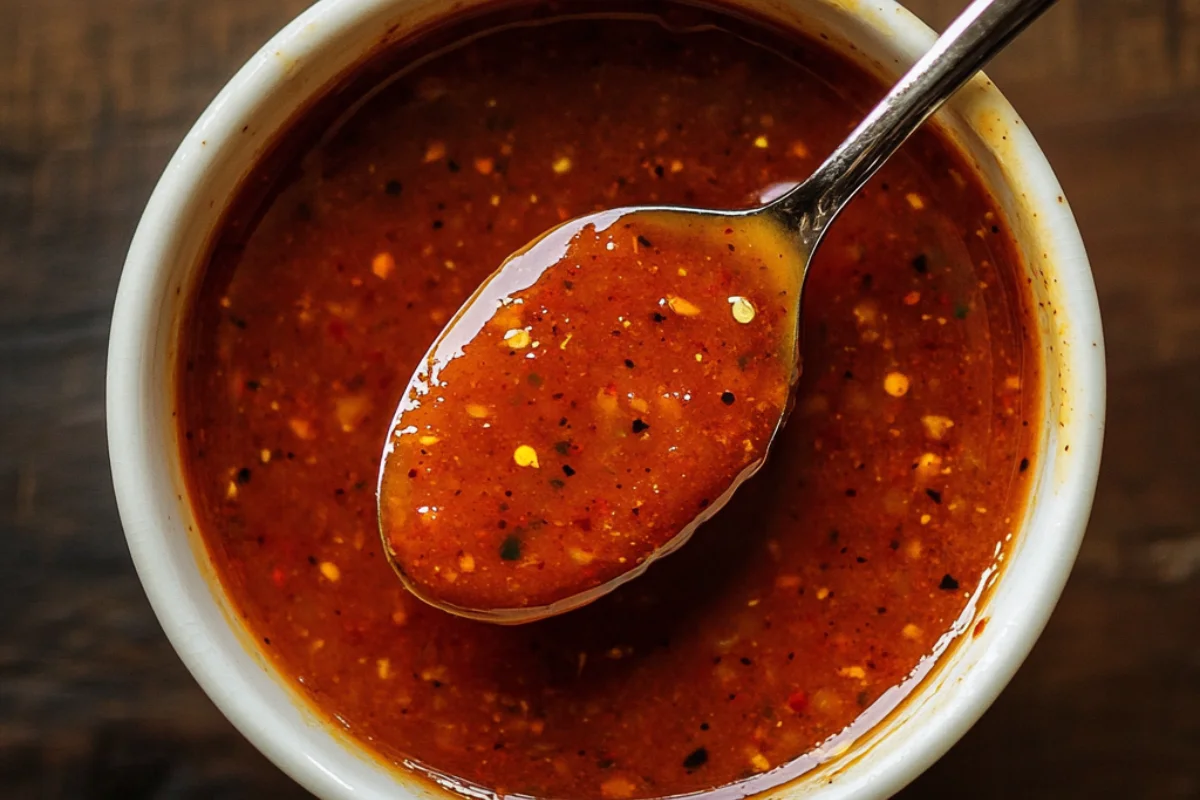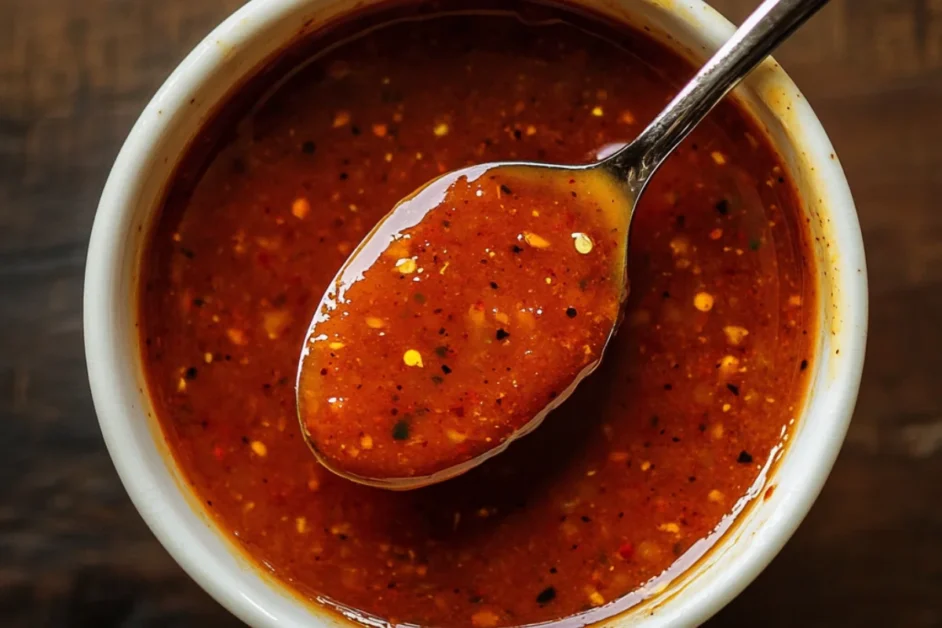If you’ve ever made or ordered chicken wings, you may have noticed that sometimes the sauce just won’t stick. Instead of clinging to the wing’s surface, it pools at the bottom of the plate or drips right off, leaving you with an inconsistent and disappointing coating.
So why does this happen? And more importantly, how can you make sure your sauce stays exactly where you want it?
In this article, we’ll break down the science of sauce adhesion, what factors influence it, and how you can tweak your cooking process for perfectly sauced wings every time.
1. Why Sauce Doesn’t Always Stick to Wings
The Role of Oil, Sauce Consistency, and Cooking Method
One of the biggest reasons sauce slides off wings is the presence of excess oil. When wings are fried, they naturally release oil, which can act as a barrier between the meat and the sauce. Since oil and water don’t mix, many traditional wing sauces (which are often water-based) won’t adhere properly.
Additionally, the thickness of the sauce matters. A sauce that’s too thin will drip off, while one that’s too thick might clump or coat unevenly.
Lastly, how you cook the wings plays a major role. Wings that are improperly prepared, undercooked, or overly greasy can prevent sauces from binding correctly.
2. The Role of Texture in Sauce Adhesion
Crispy vs. Soft Wings: How Skin Texture Affects Sauce Absorption
The texture of your wings has a major impact on how well they hold onto sauce.
- Crispy wings tend to absorb sauce better because the rough, dry surface allows the sauce to grip rather than slide off.
- Soft or greasy wings often repel sauce since their smooth, slick texture lacks the necessary grip.
Achieving the right crispiness can be done through methods like:
- Double frying: Frying the wings twice helps remove moisture, creating an extra-crispy surface.
- Baking with baking powder: A light coating of baking powder before baking draws out moisture, crisping up the skin.
- Letting wings rest: Allowing wings to rest after frying or baking helps maintain a dry exterior, which helps sauce adhere.
3. Temperature Matters: When to Apply Sauce
Hot vs. Cold Wings: How Heat Affects Sauce Adherence
One of the most overlooked aspects of getting sauce to stick is when you apply it.
- If wings are too hot, the sauce can become too runny, causing it to slide off.
- If wings are too cold, the sauce won’t absorb well and may just sit on top without soaking in.
For best results:
Toss wings in sauce when they are warm, but not straight out of the fryer. Let them rest for about 5 minutes before saucing.
If using a butter-based sauce, warm it slightly so it doesn’t solidify too quickly on cooler wings.
4. Balancing Oil and Moisture
Why Excess Oil Repels Sauce (And How to Reduce It)
Since too much oil prevents sauce from sticking, you need to control how much oil stays on the wings.
Tips to reduce excess oil:
- Drain the wings after frying using a wire rack instead of paper towels (which can create steam and add moisture).
- Pat wings dry with a paper towel before tossing them in sauce.
- Use a light dusting of cornstarch before frying to absorb excess moisture and create a better surface for the sauce.
5. Key Ingredients That Help Sauce Stick
Certain ingredients naturally improve sauce adhesion by acting as binders or emulsifiers.
- Butter: Helps create a smoother, stickier sauce that clings better to wings.
- Cornstarch: Adding a small amount of cornstarch to the sauce can thicken it and improve adherence.
- Emulsifiers (like mustard or lecithin): Help bind oil and water-based ingredients, preventing separation and improving cling.
- Honey or sugar: Slightly thickens the sauce and increases stickiness.
6. The Importance of Wing Preparation
Drying and Seasoning Techniques
How you prep your wings before cooking can make or break sauce adhesion.
Pat wings completely dry before cooking. Moisture on the skin creates steam, making the surface too soft for sauce to grip.
Season wings lightly before cooking. A dusting of flour, cornstarch, or baking powder can help create a crispier, more absorbent surface.
Avoid overcrowding when cooking. If wings are too close together, they will steam instead of crisping up, leading to a wet surface that repels sauce.
7. Using Coatings to Improve Sauce Grip
Adding a light coating to wings before cooking can drastically improve how well sauce sticks.
Popular coatings include:
- Flour: Helps create a rougher surface for the sauce to cling to.
- Baking powder: Creates extra-crispy skin by drawing out moisture.
- Cornstarch: Absorbs excess oil, reducing slickness and improving adhesion.
For best results, lightly coat wings before baking or frying. Avoid using too much, as a thick coating can become soggy.
8. Pre-Saucing Techniques
Tossing Wings in a Base Layer Before Adding the Final Sauce
One pro tip to improve sauce adhesion is to coat wings in a thin base layer before applying the final sauce.
Try these steps:
Toss wings in a light coating of oil, melted butter, or a thin glaze before cooking.
After cooking, coat them in a small amount of sauce, then let them rest for a few minutes.
Finally, toss them in the final layer of sauce for maximum flavor and stickiness.
This layered approach helps lock in sauce while creating a more even coating.
9. How Cooking Methods Affect Sauce Adhesion
Different cooking techniques influence how sauce sticks:
Frying: Produces crispy skin but can leave excess oil, which needs to be drained before saucing.
Baking: Dries out the skin more, creating a surface that absorbs sauce better.
Air frying: Similar to baking, but with more crispiness due to rapid air circulation.
For best sauce adhesion, go for baked or air-fried wings, as they develop a drier, crispier surface.
10. Does the Type of Hot Sauce Matter?
Yes! Different types of sauces behave differently on wings.
- Thin, vinegar-based sauces (like Frank’s RedHot) may slide off unless thickened with butter or cornstarch.
- Butter-based sauces tend to stick better due to their fat content.
- Thicker sauces (like barbecue or honey-based sauces) naturally cling better due to their viscosity.
For best results, adjust the thickness of your sauce as needed to ensure it coats evenly and doesn’t drip off.
Techniques to Make Hot Sauce Stick Better to Wings
If you’ve ever struggled with getting hot sauce to stick to your wings, you’re not alone. The right techniques can maximize adhesion and prevent sauce from pooling at the bottom of the plate.
In this section, we’ll cover advanced methods to improve sauce cling, from the best application techniques to emulsification hacks and thickening tricks.
11. Tossing vs. Brushing: Which Works Best?

The Two Main Methods for Applying Sauce
When it comes to coating wings in hot sauce, you have two primary options:
- Tossing: Placing wings in a bowl and tossing them with sauce.
- Brushing: Using a basting brush to apply sauce evenly.
Pros and Cons of Tossing
Pros:
- Evenly coats all sides of the wing.
- Helps sauce seep into crispy crevices.
- Quick and efficient.
Cons:
- Can lead to excess sauce pooling at the bottom.
- If wings are too oily, the sauce may slide off.
Pros and Cons of Brushing
Pros:
- Provides precise application.
- Prevents excess sauce from running off.
- Ideal for sticky, thick sauces like barbecue or honey-based sauces.
Cons:
- Can result in uneven coverage if not applied carefully.
- Takes more time.
Best practice? Use tossing for thinner sauces and brushing for thicker, sticky sauces.
12. How to Make a Sticky Hot Sauce
Adding Honey, Butter, or Cornstarch for Extra Cling
If your hot sauce is too runny, it won’t stick well. The solution? Thicken and enhance adhesion by adding:
- Honey or Maple Syrup: Adds stickiness without altering spice levels too much.
- Butter: Helps bind the sauce and coat the wings evenly.
- Cornstarch or Arrowroot Powder: Thickens the sauce slightly for better grip.
Easy Sticky Sauce Recipe
Ingredients:
- ½ cup hot sauce
- 2 tbsp butter
- 1 tbsp honey
- 1 tsp cornstarch (dissolved in 1 tbsp water)
Instructions:
- Heat the hot sauce in a saucepan over medium heat.
- Stir in the butter and honey until melted.
- Add the cornstarch slurry and whisk until the sauce thickens slightly.
- Let cool slightly before tossing with wings.
This ensures maximum stickiness while maintaining the original flavor balance.
13. Using Butter as an Emulsifier
How Butter Helps Hot Sauce Adhere Better
Why does buffalo sauce always seem to coat wings perfectly? The secret is butter.
- Butter binds the water-based hot sauce with the oil in the wings.
- It helps evenly distribute flavor and ensures the sauce sticks rather than slides off.
For best results, melt butter into your hot sauce in a 1:1 ratio before applying.
Pro Tip: Use unsalted butter to prevent the sauce from becoming overly salty.
14. The Double-Sauce Method
Applying a Base Coat, Baking, Then Re-Saucing
If you want wings bursting with sauce flavor, use the double-sauce method:
Lightly coat wings in a small amount of sauce before cooking.
Bake or air fry the wings to lock in the first layer of sauce.
Toss wings in a second layer of sauce after cooking for maximum flavor and stickiness.
This technique builds up layers of sauce, preventing it from dripping off.
15. Baking After Saucing: Does It Help?
How Heat Locks in Sauce Flavor
Yes, baking after saucing can help—but only with certain types of sauce.
- Butter-based sauces like buffalo sauce?No. The butter will separate under high heat.
- Honey-based or barbecue sauces?Yes. The sugars in the sauce will caramelize and cling to the wings.
For sticky wings, bake them at 375°F for 5 minutes after saucing. This will help the sauce set without drying it out.
16. Air Fryer Hacks for Maximum Sauce Adhesion
How Air Frying Affects Sauce Application
Air frying can actually help sauce stick better by creating an ultra-crispy surface.
To get the best adhesion:
Cook wings until extra crispy before saucing.
Toss them in a light first layer of sauce, then air fry for another 2 minutes at 375°F.
Sauce one last time after removing from the air fryer.
This locks in layers of sauce while keeping the wings crispy.
17. How to Thicken Your Sauce for Better Grip
Using Reduction, Xanthan Gum, or Starches
A thin sauce will run off wings, so thickening it is key.
- Reduction: Simmer your sauce to evaporate excess water, making it naturally thicker.
- Xanthan Gum: A tiny pinch creates a smooth, clingy texture without altering flavor.
- Cornstarch or Flour: Mix with a little water before adding to sauce.
For an extra thick, sticky sauce, let it cool slightly before applying. This prevents it from being too runny when warm.
18. The Importance of Emulsification
Why Mixing Fats and Water Properly Matters
Many sauces separate because oil and water don’t mix well. The solution? Emulsification.
To properly emulsify your sauce:
Whisk the hot sauce slowly into melted butter, rather than dumping it all in at once.
Use a blender or immersion blender for an ultra-smooth, sticky texture.
Add a small amount of Dijon mustard or lecithin to stabilize the mixture.
This creates a homogeneous sauce that evenly coats the wings without separating.
19. Dry Seasoning Before Saucing
How a Light Seasoning Base Helps Sauce Cling
Before saucing, toss wings in a dry seasoning mix to create a rougher surface for sauce adhesion.
Best dry seasonings to use:
Garlic powder
Onion powder
Paprika
A light dusting of cornstarch
Avoid too much salt, as it can draw out moisture and make wings wet.
20. The Right Ratio of Sauce to Wings
Avoiding Excess Sauce That Slides Off
If you use too much sauce, it will pool at the bottom rather than coating the wings.
Ideal ratio: About ¼ cup of sauce per 10 wings.
If sauce is too runny, let wings rest for 2 minutes before tossing again.
Applying sauce in smaller batches helps ensure better adhesion.
Pro Tips and Recipes for Perfectly Sauced Wings
Mastering the art of saucing wings isn’t just about slathering them in hot sauce—it’s about the right preparation, cooking method, and sauce application techniques to ensure the perfect balance of flavor, texture, and stickiness.
In this final section, we’ll walk through step-by-step methods, top recipes, and expert tips for perfectly sauced wings every time.
21. Step-by-Step Guide to Perfectly Sauced Wings

Preparation, Cooking, and Saucing Steps
For the best results, follow this tried-and-true method:
Step 1: Prep the Wings for Maximum Sauce Adhesion
Pat wings completely dry using paper towels.
Lightly coat with cornstarch or baking powder for crispier skin.
Season with salt, pepper, and garlic powder for extra flavor.
Step 2: Choose the Best Cooking Method
Air Frying: 400°F for 20-25 minutes, flipping halfway.
Baking: 425°F for 45 minutes, flipping every 15 minutes.
Frying: 375°F for 8-10 minutes until golden brown.
Step 3: Sauce at the Right Time
Let wings rest for 5 minutes after cooking.
Toss in a light base layer of sauce, then let sit.
Apply a final coat of sauce before serving for extra stickiness.
22. Best Hot Sauce Recipes for Sticky Wings

Homemade Thick Sauces for Maximum Cling
Classic Buffalo Sauce (Extra Sticky Version)
Ingredients:
- ½ cup hot sauce (like Frank’s RedHot)
- ¼ cup unsalted butter
- 1 tbsp honey (for extra cling)
- 1 tsp cornstarch (mixed with 1 tbsp water)
Instructions:
Melt butter in a saucepan over medium heat.
Stir in hot sauce and honey.
Add cornstarch slurry and whisk until thickened.
Honey-Sriracha Sticky Wing Sauce
Ingredients:
- ⅓ cup Sriracha
- ¼ cup honey
- 2 tbsp soy sauce
- 1 tbsp butter
- 1 tsp cornstarch
Instructions:
Simmer all ingredients in a saucepan until slightly thickened.
Let cool slightly before tossing with wings.
23. Using Cornstarch or Flour for Extra Stickiness
How to Coat Wings for Better Adhesion
A light dusting of cornstarch or flour before cooking absorbs excess moisture, leading to:
Crispier skin that grips sauce better.
A rougher texture that prevents sauce from sliding off.
How to do it:
- Toss wings in 1-2 tbsp of cornstarch or flour before frying or baking.
- Shake off excess to avoid a pasty texture.
24. Why Letting Wings Rest Improves Sauce Retention
Allowing Sauce to Absorb Before Serving
Many people make the mistake of serving wings immediately after saucing—but letting them rest locks in flavor.
Why it works:
Resting for 3-5 minutes allows sauce to absorb into the crispy skin.
Prevents sauce from running off when wings are too hot.
Helps create a more even, sticky coating.
Pro Tip: Let wings sit on a wire rack instead of a plate to avoid sogginess.
25. Glazing vs. Dipping: Which Holds More Sauce?
When to Dip vs. When to Glaze
- Glazing:
Coating wings with sauce during or after cooking.
Best for sticky, thick sauces like honey mustard or BBQ. - Dipping:
Serving sauce on the side for dunking.
Ideal for thin, runny sauces that don’t cling well.
Best method? Glazing + a final dip for extra saucy wings.
26. Avoiding Common Mistakes
Over-Saucing:
Drowning wings in sauce makes them soggy.
Use just enough to coat, then layer gradually.
Saucing Too Early:
Adding sauce when wings are too hot can make it slide off.
Let wings rest for 5 minutes before saucing.
Using the Wrong Sauce Ratio:
Too much vinegar makes sauce runny.
Thicken with butter, honey, or cornstarch.
27. Best Store-Bought Sauces That Stick Well
Frank’s RedHot Buffalo Wings Sauce – Classic and sticky.
Sweet Baby Ray’s Honey BBQ – Thick and sweet for maximum adhesion.
Gochujang Korean Chili Paste – Naturally thick and spicy.
Buffalo Wild Wings Parmesan Garlic – A creamy, clingy sauce option.
Pro Tip: If a store-bought sauce is too thin, thicken it with a bit of butter or cornstarch.
28. Alternative Binding Agents for Sticky Sauce
Using Mayo, Mustard, or Yogurt-Based Methods
- Mayo: Helps thicken and stick to wings better (great for spicy garlic wings).
- Mustard: Acts as an emulsifier, helping sauces cling.
- Greek Yogurt: Creates a creamy, sticky texture for Indian-style or Mediterranean wings.
Try adding 1 tbsp of mayo or mustard to your sauce to improve adhesion.
29. Serving and Presentation Tips
How to Make Your Wings Look as Good as They Taste
Plating: Use a large platter to avoid overcrowding.
Garnishing: Sprinkle with fresh parsley, sesame seeds, or chives.
Dipping Sauces: Serve with ranch, blue cheese, or extra hot sauce on the side.
Pairing: Serve with celery, carrots, or fries for balance.
Pro Tip: Drizzle a little extra sauce on top before serving for restaurant-quality wings.
30. Final Thoughts: The Perfect Wing Sauce Formula
Key Takeaways for Perfectly Sauced Wings
Dry wings before cooking to maximize crispiness.
Use cornstarch, flour, or a base glaze to improve sauce grip.
Apply sauce at the right temperature (warm wings, not piping hot).
Use butter, honey, or emulsifiers for extra cling.
Let wings rest after saucing for maximum absorption.
With these pro tips and recipes, you’re now equipped to make perfectly sauced wings every time.
FAQs
What’s the best way to reheat sauced wings?
Use an air fryer at 350°F for 5 minutes to keep them crispy.
Can I make sauce stick better without butter?
Yes! Use cornstarch, honey, or mustard as alternative binders.
Why does my sauce separate?
You need better emulsification—whisk in butter slowly or use an immersion blender.
Should I sauce wings before or after cooking?
After cooking is best for most sauces, but glazing before baking works for sticky sauces.
What’s the secret to ultra-sticky wings?
Double-saucing: Toss wings in a light coat, bake, then toss again before serving.

